|
Monday, May 8 – Goreme, Cappadocia
Goreme is a little village in the Cappadocia region, better known as the “Valley of the Fairy Chimneys.” The "chimneys" are towering weathered rocks that started 10 million years ago when three volcanoes erupted in this area. First the thick layer of volcanic ash hardened and compacted into soft, porous rock called “tuff.” Then erosion wore the layers away. However, harder rock on top of the tuff protected the tuff from wind and rain erosion resulting in strange large cones of mushroom-capped columns. (Several folks in Cappadocia referred to the rock as “tufa”, but an Internet search revealed that “tufa” is a very hard calcium carbonate and is not volcanic.)
The whole Cappadocia area looks like a set for Star Wars or the Flintstones. (In fact, one of Goreme’s local watering holes is called,”Flintstones.”) The rock is soft enough that people have been carving homes, hotels, churches, and shops into the towering rock structures for thousands of years. We stayed in the village of Goreme. This area is a MUST SEE for anyone coming to Turkey.
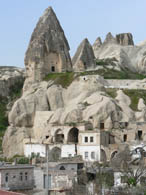
Goreme’s Fairy Chimneys |
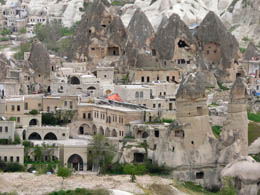
View from our breakfast room |
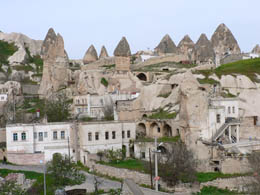
Goreme |
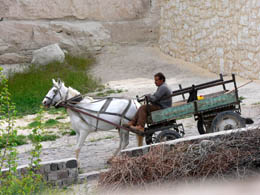
Going into town |
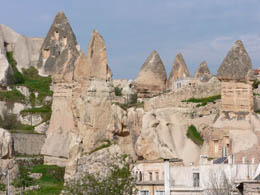
Goreme
|
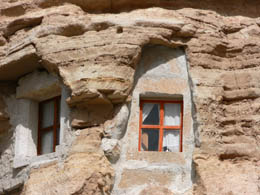
House built of stone
|
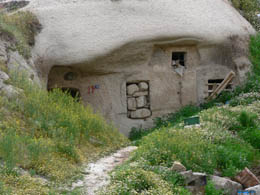
Hobbit house |
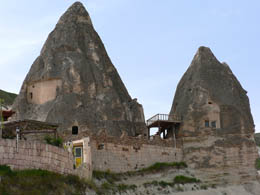
Duplex |
After arriving on the bus, we walked over to the Tourist Information Office and asked them to call our hotel, the Goreme House. Goreme House said to just walk over to the hotel, as it was only a couple hundred meters. Ahmet from the hotel met us about half way there to help with our luggage. Our room was available (although it was 6:45 a.m.) so we showered and did a ton of laundry.
I really liked the room and the very fine views of this landscape from another world. I snapped a lot of photos from our rooftop breakfast room, perched on the 4th floor. Breakfast was nice, with fresh orange juice.
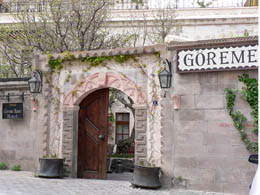
Goreme House |
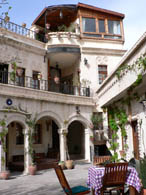
Our room was in the right corner |
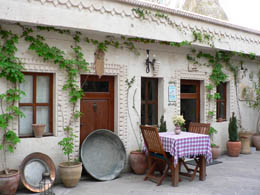
Goreme House patio |
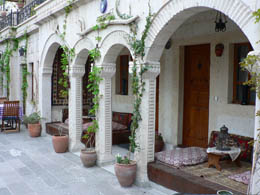
Goreme House |
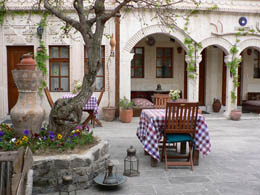
Goreme House
|
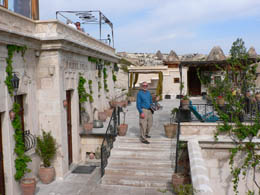
Bill heads up to breakfast
|
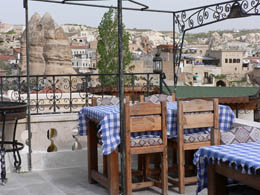
Rooftop breakfast room |
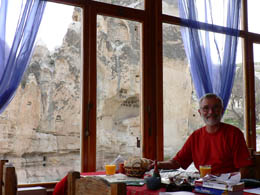
Bill enjoying his breakfast! |
| NOTE: Most people who come to Cappadocia think they have to stay in cave rooms and pay extra for the “cave room” experience. Bill found the Goreme House on the Internet and thought we could do just fine without a cave room. The room turned out to be wonderful. In fact one former “cave room purist” confessed to us that her cave was damp, musty and cold and her laundry never dried. Remember, a cave room is not a requirement for enjoying this wonderful place. |
We talked to Mukbale, the hotel manager (the owners were out of town for a couple of days). She’s a take-charge person. In no time she made a few phone calls to confirm our balloon ride, arrange a trip to see the Whirling Dervishes, and make reservations for our bus ride to Ankara. She also gave us some restaurant recommendations.
At 10:30 we began our sightseeing by walking through town and doing a little shopping. We bought Zi a genie costume, Jenny a belly dancing belt and Bill bought a CD—Anatolia Café—which he had heard at our hotel.
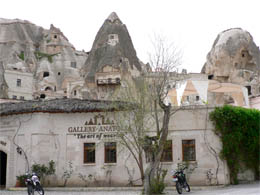
Main Street – Goreme |
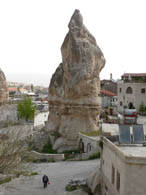
In the center of town |
Cappadocia is mostly agricultural with crops of wheat, potatoes, apricots, and pumpkins to name a few. We saw lots of apple trees and walnut trees and grape vines tucked among the rock formations. The vines here are gnarly with strong roots extending 45 feet to the water table – no need to water them. We also saw horses, dairy cows, sheep and goats. The small family farm is different here where cooperative farming is organized in the villages. The farmers (and their families) live in the villages and go out to the farm everyday. The older people still gather dung for fuel.
Our goal for the day was to explore Goreme’s main attraction, the Open Air Museum, tucked away in a canyon loaded with massive rock caves that once were home to monasteries and churches. On the way to the Open Air Museum, we hiked along the ridge overlooking the main road to get a bird’s eye view of the museum. I wanted to scramble down to the valley where the museum is, but Bill said it was too dangerous, so we retraced our steps back to the road. We couldn’t believe our eyes – never saw such wonders. I’ll let the photos speak for my lack of adjectives.
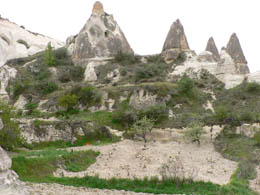
Notice the garden in the foreground |
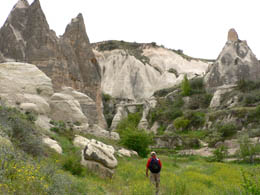
Bill headed into another valley |
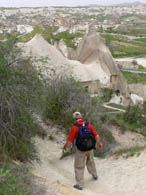
Bill headed down |
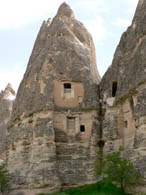
Oh wow |
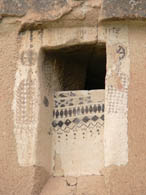
Notice the window treatment |
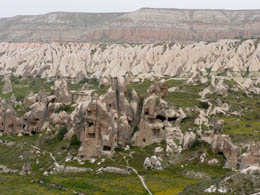
Valley loaded with Fairy Chimneys |
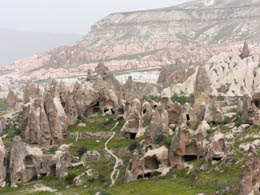
More Fairy Chimneys |
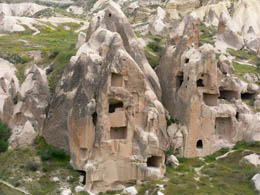
Views of the “hood”
|
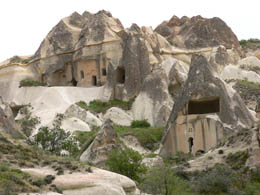
More views of the “hood”
|
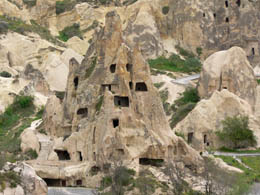
Still more views of the “hood” |
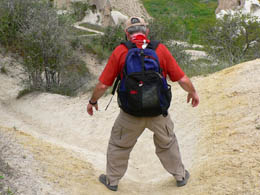
Bill heads down |
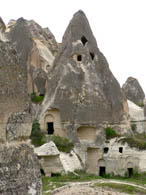
They all live in pointy houses |
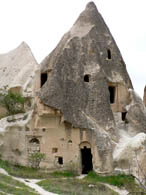
Another pointy house |

Pointy pottery shop |
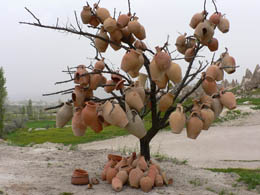
Pottery shop display
|
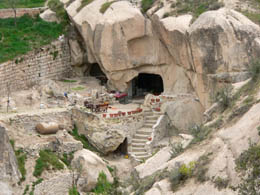
Restaurant
|
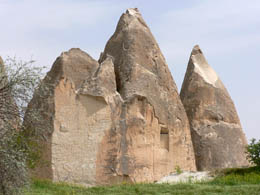
Only needs a few windows
|
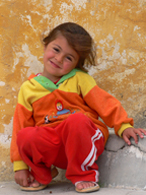
Cutie Pie at the pottery shop
|
The world heritage Goreme Open Air Museum is a complex of Byzantine churches, monasteries and other associated dwellings all carved out of rock. It was an early center for religious education. In the 4th century, St. Basil the Great, disillusioned with how materialistic the church had become, moved to Cappadocia and started the first monastery that emphasized poverty, obedience, and religious devotion. The caves provided protection from the harsh weather and a place to hide from enemies.
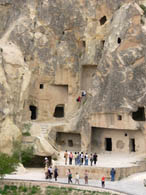
A few tourist groups |
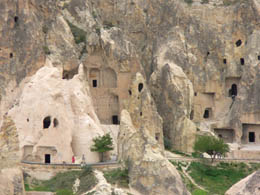
Main complex of churches |
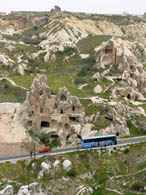
Always-present tour bus
|
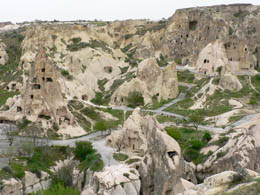
Main complex of churches
|
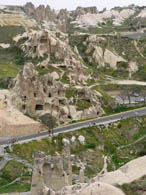
Road out of the Open Air Museum |
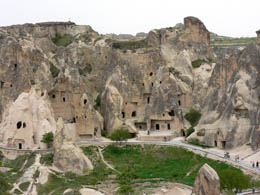 Main complex of churches
Main complex of churches |
We hired Murat, a guide we met at the entrance, to walk us through the museum and give us the history. There are about 10 different churches, stables, kitchens, dining rooms, chapels and burial places. The simple holes-in-the-wall entrances to the caves opened up to columns and arches that were carved from the rock. Some of the churches had elaborately painted frescos and some had primitive symbols (e.g. turtles and snakes). During the Iconoclastic Period in the 8th century, some of the eyes were scratched out because religious leaders were afraid that religion had become too focused on symbols. Murat said this was the origin of the “evil eye.”
Here are some of the things we saw in the Open Air Museum:
- Monk’s convent (which was connected to the nun’s convent).
- Church of St. Basil, which is dark and has niches for graves.
- Apple Church, a small cave church with elaborate frescoes depicting biblical scenes, including Archangel Michael overlooking an apple orchard.
- Church of Santa Barbara, with crudely painted geometric patterns.
- Snake Church, which is named for the fresco of St. Theodore and St George slaying the dragon (or snake). The church also has a fresco of Emperor Constantine and his mother Saint Helena holding the "True Cross."
- Church of the Buckle, the largest church in the Open Air Museum. It has frescoes of the twelve apostles, the saints and scenes from the life of Jesus.
- Pigeon House, where little alcoves are hollowed out of the rock so pigeons can make their nests. The farmers use their droppings for fertilizer in this very agriculturally rich area.
NOTE: The little churches were filled with frescoes dating back to the second century A.D. They started painting them with just red icons, then moved on to more colorful stuff when the church relaxed its stand on icons.
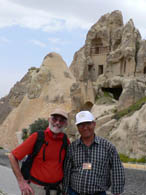
Bill and Murat, our guide |
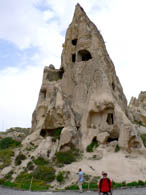
One of the churches in the complex |
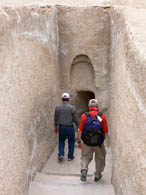
Murat leads Bill down into a cave |
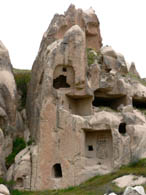
One of the churches |
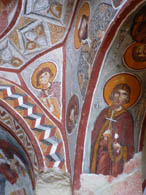
Apple Church – Resurrection of Lazarus
|
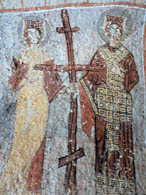
Snake church – the “True Cross” |
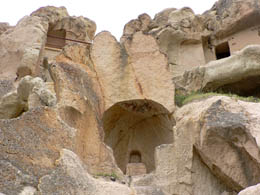 Painting left on ceiling
Painting left on ceiling |
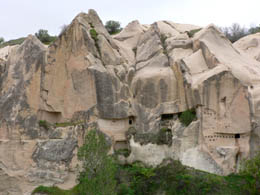
Church complex |
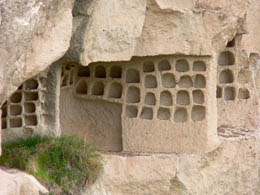
Pigeon houses |
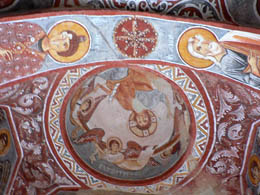
Painting on arches overhead |
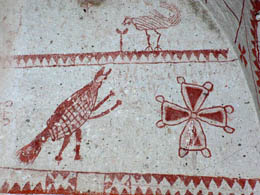
Church of Santa Barbara - primitive paintings |
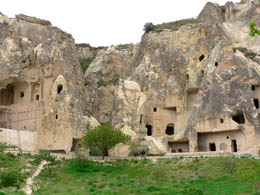
Churches and monasteries |
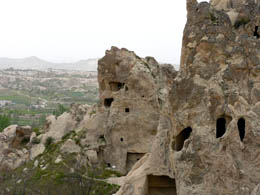
Monasteries |
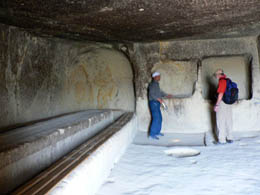
Monks’ dining table |
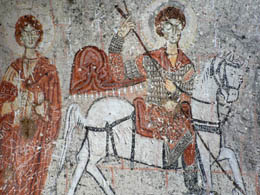
Snake church |
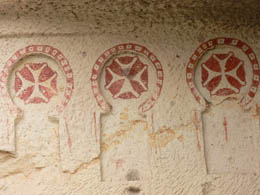
Primitive paintings |
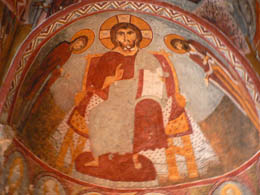
Refined fresco |
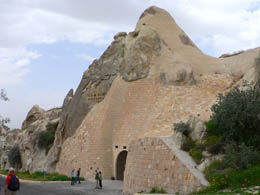
Church of the Buckle – Largest church in the museum |
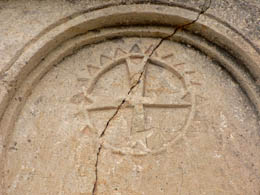
Outside carving |
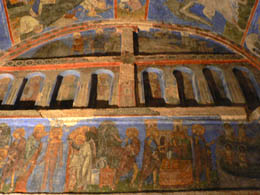
Church of the Buckle – interior |
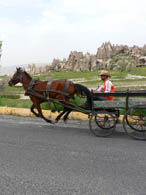
Racing home |
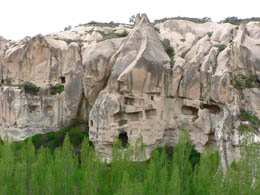 Open Air Museum
|
At the end of our tour, Murat, our intellectual, fact-filled tour guide, turned into a carpet salesman before our eyes. He offered to take us to a carpet shop and to a pottery shop. We weren’t interested, so we paid him his 20 lira ($15), bid him good-bye, and walked back to town. We stopped at the SOS Café for a beer, where our 23-year old waiter sang American songs to me. Bill was falling asleep at the table. We walked back to our room for a shower. I caught up on my journal and studied some books about Cappadocia that I borrowed from the hotel’s library.
We heard thunder, then heavy rain for only a few minutes. We walked to town for dinner at Dibek Restaurant, a 475-year old former stable that has been converted into a cozy restaurant. We sat on cushions at a round table and ate lentil soup, salad, rice and a chicken-tomato-onion stew. It was very good.
We got to bed early so we’d be ready for our early morning pickup by Kapadokya Balloons.
Tuesday, May 9 – Goreme, Cappadocia
The 4:30 call-to-prayer woke us up just before our alarm went off. Then came our wake-up call. The van from Kapadoyka Balloons picked us up at 5:05. The sky was overcast, but the winds were perfect for a hot air balloon ride. We were delivered to the main office for check in, biscuits and tea. Everyone was paying 160 euros for their balloon ride, but we had prepaid 150 euros ($200) in Istanbul. We were all loaded onto vans and driven to the launch area a few miles away.
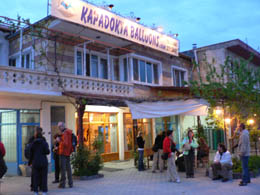
Kapadoyka Balloons Office |
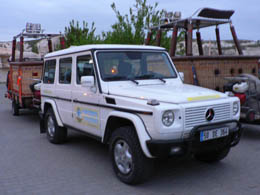
Pack up the balloons |
There were 6 balloons, each holding about 15 passengers. Our balloon was named “Kia”, advertising the car company. It was interesting watching the very professional crew inflate the balloons with hot air. Our pilot was Mike, a tall Brit with 16 years as a hot air balloon pilot. He gave us a running commentary about the balloon, how the vents made the balloon go up and down and turn. He obviously loved his job, which gave all us passengers confidence. We had an hour of incredible views, ascending to get a good overview of the terrain, then descending into the deep canyons with their mind blowing rock formations. We were so low that the bottom of the balloon’s basket scraped the tops of trees. I loved floating among the balloon traffic jam in the sky and hearing the radio communication with Mike and the other pilots. It was a dreamlike experience. Bill captured all the moments with his video camera. (Click here to view Bill's video if you have a broadband connection to the Internet.)
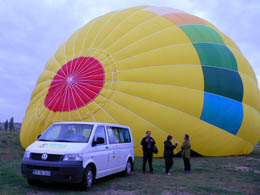
Fill ‘er up |
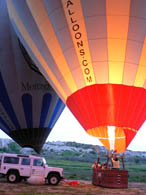
Heat the air |
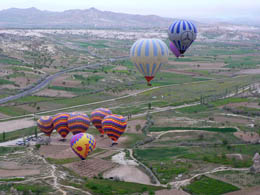
Lifting off |
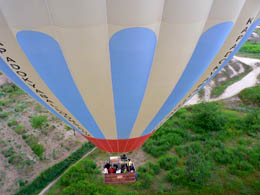
Up, up and away |
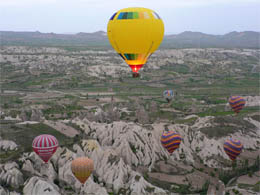
Rising yellow balloon |
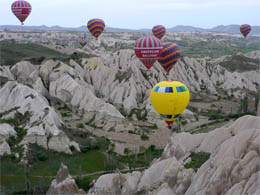
Lowering yellow balloon |
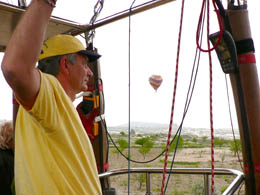
Our pilot Mike |
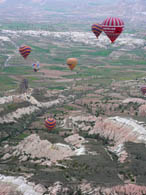
Watch out for the traffic jam |
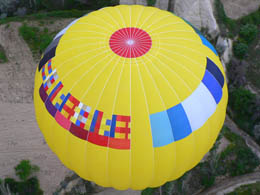
Just below us |
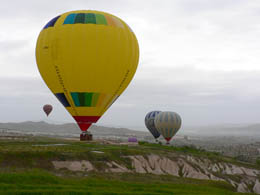
Lovely sight |
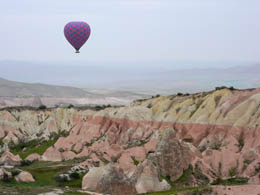
In for a closer look |
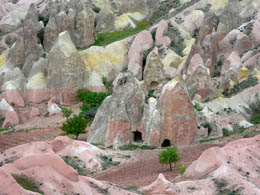
Amazing landscape |
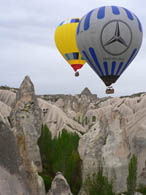
Lower into the canyons |
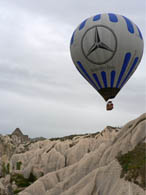
Even lower |
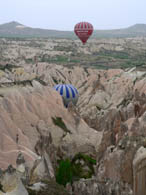
How low can you go? |
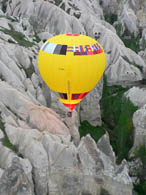
Have a look around
|
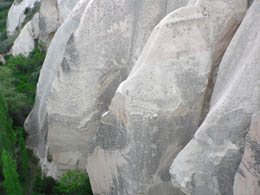
What a view!
|
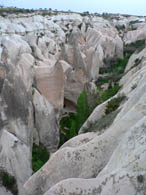
So many places to explore
|
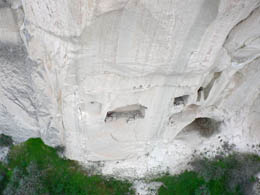
Above the sheer canyon walls
|
As we descended for our landing, we watched the vans with trailers circling around on the roads below, trying to anticipate where we would touch down. Mike was very picky about our landing spot. He wouldn’t land on private farmland. He wanted to land on a road so the crew could easily load the balloon onto the trailer. As we came down we all assumed our “landing position”, just in case the basket tipped over. Once we were on the ground, we had to remain in the balloon so Mike, with the help of the ground crew, could fire the burners to allow the balloon to lift itself up on the trailer. They needed the weight of the passengers for stability. To celebrate our safe return they served us Champaign and gave each of us a certificate. They delivered us back to the hotel at 7:30 a.m. We went up to the rooftop café for breakfast while visions of floating danced in our heads.
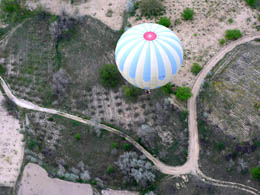
Descending |
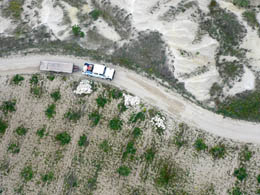
Here comes our ride |
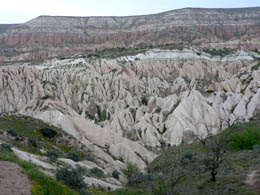
Unreal
|
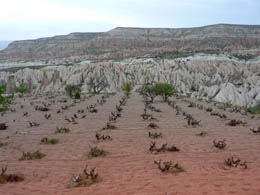
Vineyards
|
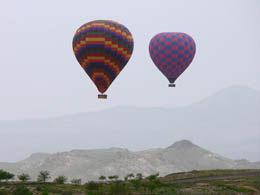
Ride’s almost over |
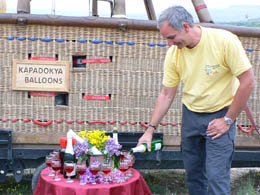
Champaign toast |
At 9:30 we were ready for the tour Mehmet in Istanbul had booked for us. By 9:45, there was still no van so we asked Mukbale to call the tour company. Mehmet had faxed the wrong dates and our tour had already left. Mukbale swung into action, called another tour company and made all the arrangements within 2 minutes. A few minutes later the van from Yama Tours picked us up and we were on our way.
The highlights of the all-day tour were the underground city of Derinkuyu and the Ihlara Canyon. Our guide was Mehmet, who was full of information. Other passengers on the van were a Korean family, an Asian couple on their honeymoon, and an Australian couple, and Jeff and Kath, with whom we bonded and became fast friends (which happens so quickly when you’re on the road).
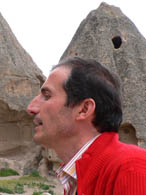
Mehmet, our guide, proud of his nose like the great conquerer Mehmet |
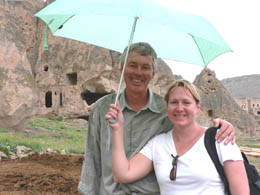
Kath and Jeff – Aussie friends |
Our first stop was an overlook to get a beautiful view of Goreme and Pigeon Valley. Mehmet used a stick to draw a map in the dirt as a visual aid for his history lesson. In 15 minutes I learned more about Turkey and its history than I had learned during my previous 2 weeks in Turkey. We learned that Cappadocia was once the heart of the Hittite Empire (1800 BC– 1200 BC), then the Persians came and conquered, followed by the Romans (spreading the empire and chasing the Christians – 400 – 1100 AD), then the Byzantines. Cappadocia means “land of the wild horses.” The Hittites tamed and used these horses in war. The Hittites also invented using the wheel for carts, based on the potter’s wheel. Later they invented the chariot – a major breakthrough in war strategy. They could now move armies quickly by carrying 3 soldiers (in a chariot pulled by one horse) off to battle instead of the one soldier, one horse model. During the battle using this new chariot weapon, with one driver and two soldiers on the back shooting their arrows, they could really mow down the enemy. No one had ever seen anything like this – amazing fighters and warriors (if that’s your thing).
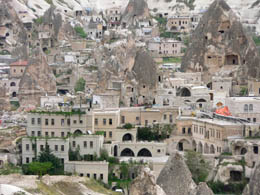
Goreme, from the overlook |
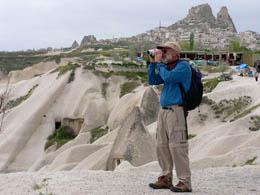
Bill checks out the view |
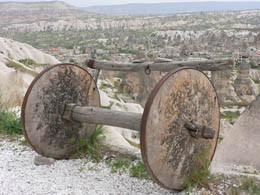
Ancient wheels |
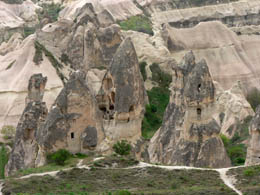
Pigeon Valley from the overlook |
Our next stop was the underground city of Derinkuyu, one of over 200 underground cities in the Cappadocia. No one is certain who began digging the underground cities, but some archeologists think they might go back 3000-4000 years. Early Christians sought shelter from the Roman soldiers, and in the 6th century the cities provided shelter from invading Arabs. Derinkuyu looked like an ant farm, going down 8 levels, with rooms for wineries, stables, cellars, storage, refectories, and churches.
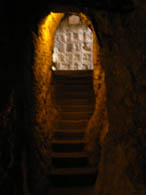
Inside my first underground city – No claustrophobics allowed |
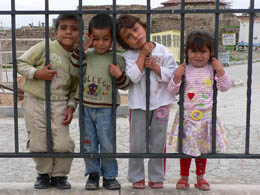
Little scallywags outside the entrance to the underground city |
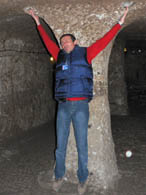
Mehmet – demonstrating torture treatments |
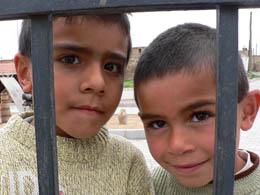
A couple of young Turks |
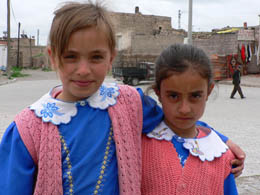
Girls in their school uniforms |
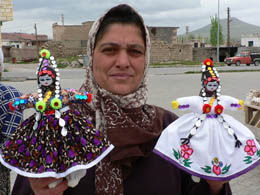
Please buy my dolls |
After we left Derinkuyu, we drove to the small town of Ihlara to begin our trek through the Ihlara Valley. Churches were carved in the cliffs overhead. Mehmet took us through one of the 30 churches to see what is left of the frescoes. Ihlara is a peaceful valley with a wide rushing river lined with graceful trees and farmland. One young Asian boy in front of me kept stopping to take my hand to help me over some rocks. I would have preferred that he left me alone (little did he know what an animal I am), but part of me thought, “what a sweet gentleman.” We should all move to Asia when we get old (older).
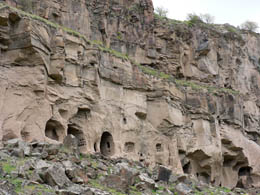
Ihlara Valley |
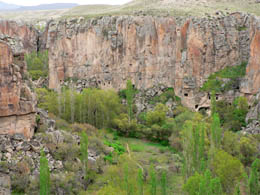
Ihlara Valley |
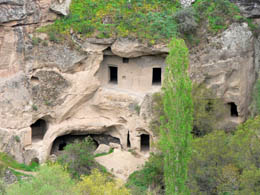
Churches carved in the cliffs
|
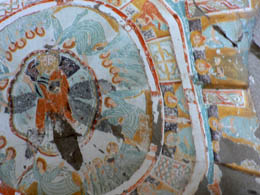
Token fresco
|
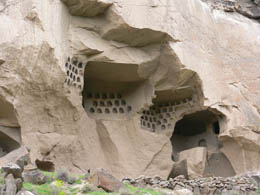
Pigeon houses everywhere |
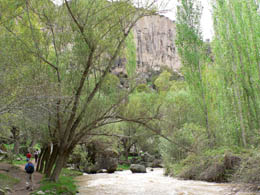
Gorgeous hike along the river |
We stopped for lunch at a nice place (considering it was part of the tour). We sat with Jeff and Kath. What a darling couple. He’s retired and getting hooked on Photo Shop. They have a son who's studying graphic design in San Francisco.
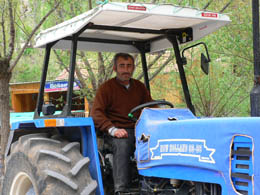
Riding his tractor into town for lunch |
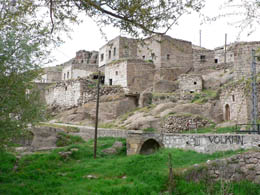 Town where we had lunch
Town where we had lunch |
After lunch we drove to the Selime Monastery. We climbed up the side of a steep hill and walked around the ancient monastery. 300-400 monks once lived here, looking for enlightenment through a simpler life. We bumped into the 2 Aussie gals I first met in the Turkish bath in Antalya. It’s amazing how often that happens when traveling.
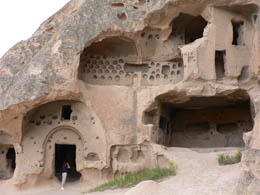
Ancient Monastery |
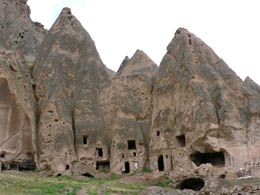
More of the Monastery Complex |
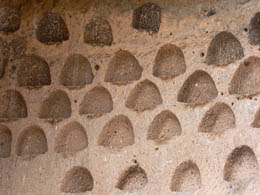
Carved pigeon houses |
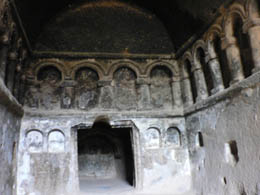
Monastery interior |
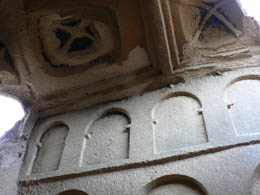
Monastery interior |
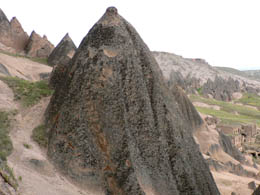
Cone shaped fairy chimney |
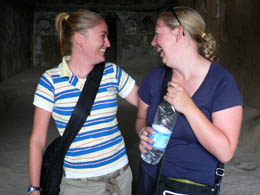
Two Aussie pals we kept running into |
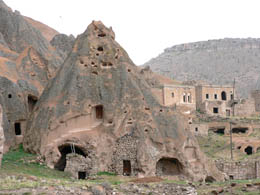
Strange neighborhood |
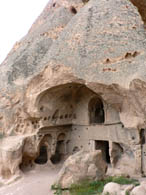
Entrance to monastery |
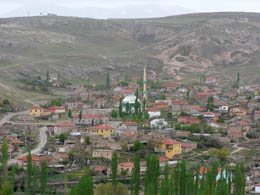
Little mosque in the valley |
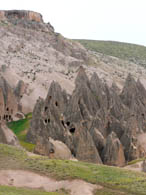
Grouping of cones |
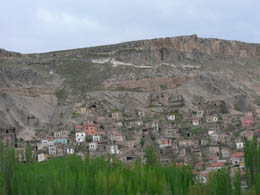
Little suburb in the valley |
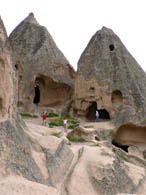
Another monastery entrance |
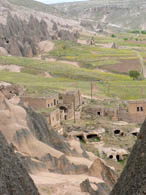
View of the town from the monastery |
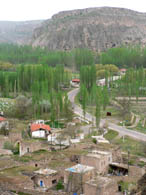
View from the monastery |
Jeff bonded with some of the local kids, asking them questions and playing with their puppies on the way back down to the van.
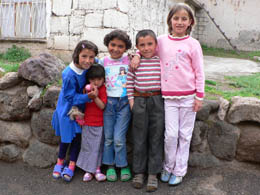
Local kids |
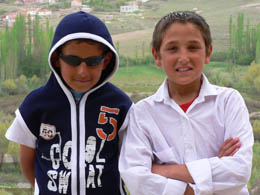
Future tough guys |
Mehmet told us the story of Prophet Mohammed. Muslims believe that God first sent Christ as his messenger to warn the people that He is not happy with the way things are going down on earth. Then, 600 years after his first messenger, He sent another messenger, Mohammed, with the same warning. God was getting impatient so Mohammed’s teachings would be humankind’s last chance.
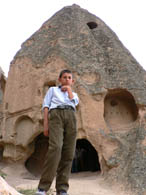
Local kids |
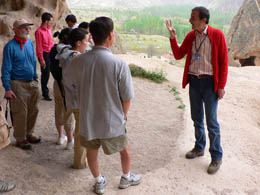
Mehmet – excellent guide! |
We drove to the village of Guzelyurt noted for the church of St. Gregory. We climbed a hill to get a peek at the church. It was first built in 385 and then replaced by a larger building in 1896. Ethnic Greeks lived in the village and worshipped here from ancient times. Then came “the exchange of populations” between Greece and Turkey after World War I. The Greeks were forced to resettle in a new village near Kavala, Greece. In their place came the ethnic Turks from the Greek towns. With the Christians gone and Muslims arrived, the great church became a mosque.
NOTE: Mehmet told us that the country of Turkey suffered a huge loss with the “Greek – Turkey population exchange” because most of the Greeks who left were educated and most of the Turks who came were country bumpkins. For 20 years or more, there were no teachers in many of the villages. Losing the country’s top intellectuals had a major impact in many areas of development.
We had about 15 minutes to explore Guzelyurt. I wandered down a dirt street to the Tourist Information Office, then through some back streets to see butcher and carpentry shops. Guzelyurt has a large, rundown, town square where old men chatted in front of a large statue of Ataturk’s head. A statue of Ataturk is displayed in almost all Turkish towns. Guess this little town could only afford a head of Ataturk – but it was a big head.
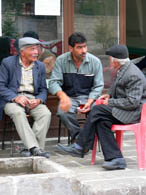
Turkish men sitting around – common sight |
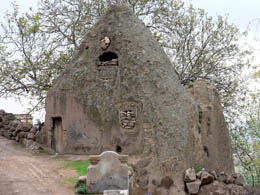
Strange house |
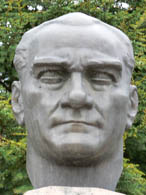
Ataturk’s head |
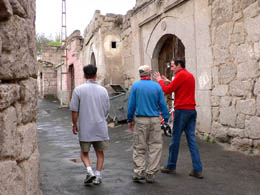
Mehmet shows us around town |
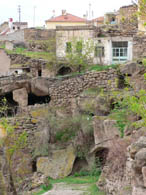
Guzelyurt |
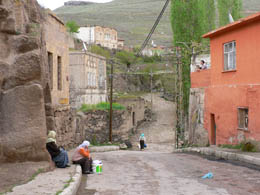
Guzelyurt |
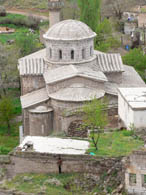
Church of St Gregory |
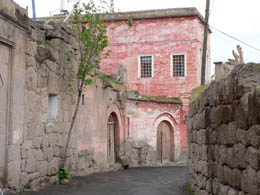
Guzelyurt |
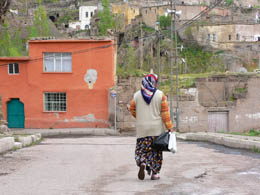
Guzelyurt |
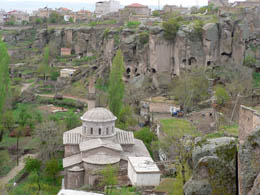
Church of St Gregory turned mosque nestled in Guzelyurt |
The drive back to Goreme was about an hour. I talked to Jeff and Kath while Bill snoozed in the row in front of me. We discussed the doom and gloom of the world—the senseless war in Iraq, immigration dilemma, global warming, the stupidity of George Bush, China and the new balance of power. They would have enjoyed Bill’s facts and figures much more than my ramblings, I’m sure.
Before we returned to Goreme, we made one last stop—Nar Lake. It’s round, green and in a volcanic crater. Mehmet said the lake is hot (we took his word), and that the green color is a reflection of the green landscape.
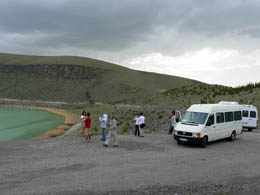
Bus stop at Nar Lake |
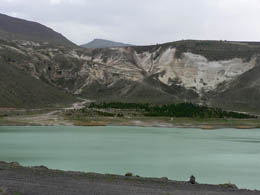
Nar Lake |
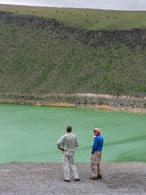
Bill and Jeff |
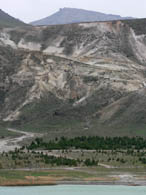
Mountains behind Nar Lake |
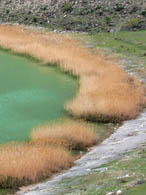
Shores of Nar Lake |
As we drove back to Goreme, we were treated to the most magnificent rainbow. You could see both ends, but no pot of gold. The bus let us out in Goreme. We had beer with Jeff and Kath at the SOS and then switched to red wine. It was delightful getting to know them. They were not like all the other crazy, partying Aussies we encountered. They were much more serious.
Bill and I decided that this would be our splurge night for dinner. Goreme has a restaurant—the Alaturka—that Lonely Planet rates as one of the 5 best in Turkey. The restaurant was elegant. We had salad, manti (ravioli covered with yogurt), a chicken dish and pastry. Nice, but they don’t come close to Saban’s meals in Cirali. The Goreme House had told us to mention that we were staying there and we’d get a 10% discount. Our waiter just smirked and delivered the check with no discount – oh well.
Back at the hotel, Murat, the owner, asked about our dinner. When we told him that we didn’t get the discount, he called the restaurant to arrange coffee and brandy tomorrow, on the house. Murat is a take-charge guy who really watches out for his clients.
Exhausted, with our brains and tummies full, we went to bed.
Wednesday, May 10 – Goreme
After another lovely breakfast in the Goreme House rooftop restaurant, the van from Heritage Tours picked us up at 9:30. We rendezvoused with the rest of our group at the Kelebek Hotel. Our fellow travelers for today were 2 guys from Seattle and 2 American women of Pakistani descent (both Muslim).
We met our adorable guide, Daira, a charming and smart young Turkish woman of about 25. We drove by the college she attended in the 1990’s. Local residents would throw apples at her and her friends because the locals didn’t approve of the coed dormitories. Daira said she had been “apple-ed” (instead of stoned, as she might have been in other times).
Our first stop was the same Pigeon Valley overlook where we had stopped the day before. Daira told us about the geological formations, and how volcanic activity had created the weird Cappadocian landscape.
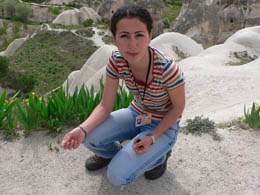
Daira, our guide, at Pigeon Valley overlook
|
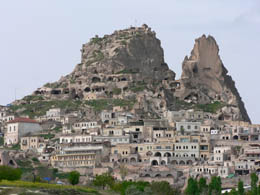
Uchisar |
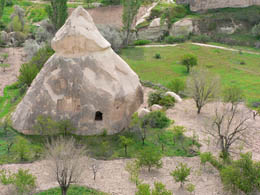
Farming area down below |
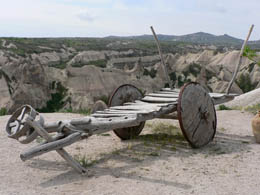
Ancient cart parked on the edge of Pigeon Valley overlook |
We drove to the underground city of Kaymakli. It was similar to Derinkuyu, which we saw yesterday, but a little more interesting. Kaymakli was built for protection during the Hittite era (2nd Cent. A.D.). Underground cities were key to survival in this area. The Cappadocian countryside was constantly playing host to armies moving east and west, gathering supplies and young men to battle with them. Early Christians escaping from Roman persecutions found shelter in the underground cities as well.
Kaymakli was an 8-story underground city carved in the soft volcanic “tuff.” Not only were there carved spaces for schools, bedrooms, bathrooms, kitchens, storage rooms, wine cellars, chapels, airshafts, staircases, water wells, and graves, but there were also connecting tunnels to other underground cities and tunnels leading up into farmhouses. It was a regular ant farm. No one would ever know from the ground level that there were several thousand people living down below at one time. The underground quarters were only occupied during times of danger – which could be months at a time.
A lot of thought went into designing the defense systems. They installed fake water wells so that invaders would poison these waters and then be on their way.
The entryways were very cramped and had round carved stone doors set to roll into place which were nearly impossible to move. Sometimes the stone doors were left open so that the invaders were allowed passage and then trapped so the underground city dwellers, hiding in an overhead room, could pour hot boiling oil through holes in the ceiling. These guys were serious about defense. Times must have been really brutal.
We explored the city in very narrow passageways that required constant stooping. I had such respect for the 2 guys from Seattle (both of whom had some kind of hip or leg disability) for crawling through the tiny passageways with their handicapped bodies, but soaring spirits.
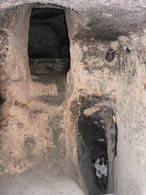
Passageways in the underground city |
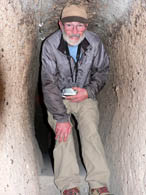
Bill trapped in a passageway |
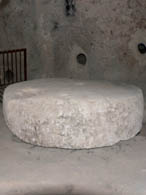
Round door to cover entrances |
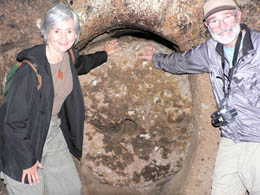
Bill and Nancy at the door
|
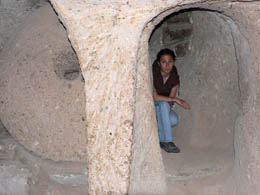
Daira demonstrating how to trap the enemy |
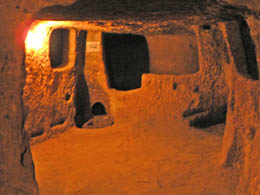
Underground city winery |
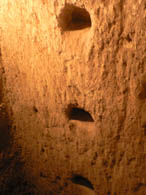
Hand / foot niches to crawl up the 8-story city vent |
Our next stop was a family-owned winery to taste (but not buy) their red and white wines, which were OK, but not as good as the full-bodied California wines. Although Cappadocia is known for its local wines, one doesn’t really drink wine here, one drinks history.
We did a short hike through Kesisler (Mushroom) Valley, with its amazing structures, formed by the elements. The structures looked like giant phallic symbols, circumcised at that.
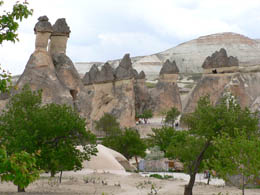
Mushroom Valley |
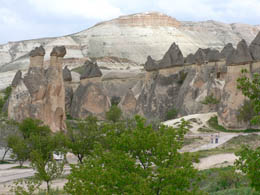
Mushroom Valley |
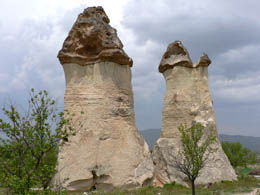
Mushroom Valley
|
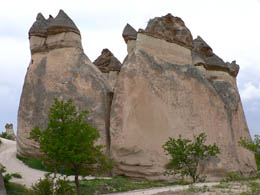
Mushroom Valley
|
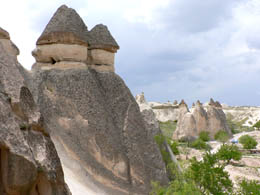
Mushroom Valley |
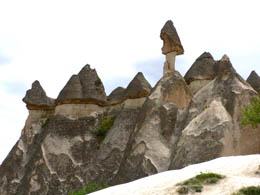
Mushroom Valley |
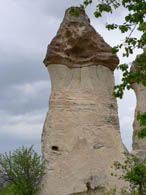
Phallic or what?
|
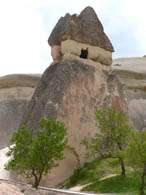
Mushroom Valley |
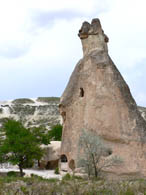
Mushroom Valley |

Entrance to the main monastery in Mushroom Valley |
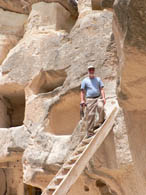
Bill explores the monastery caves
|
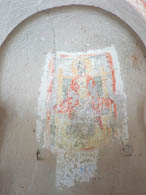
Faded fresco in a cave |
Lunch was at an elegant cave restaurant. The theatre-style marble tables formed a semicircle around a stage. I felt sorry for the poor musicians with their artist souls stuck in that noisy place enduring endless flashes from our cameras while trying to play a little music. Most of the guests were Japanese with large tour groups. One group was celebrating a birthday – yet another tune for the musicians to play. Lunch was fine (for tour bus fare) -- bland soup and a traditional Turkish dish cooked in a clay pot. The pot is usually broken with a hammer, but the chef, after a big fanfare, simply removed the lid off ours – what’s the big deal?
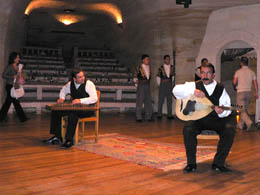
Bored musicians |
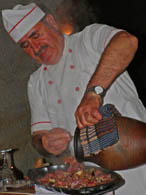
The chef serves up our lunch |
We stopped at a pottery shop in Avanos, a town famous for its pottery. We were herded from room to room with demonstrations at each stop (prepare clay, throw, paint, glaze, bake, etc.), and then emerged in the Gift Shop. None of us wanted to buy anything so we huddled together while a gaggle of sales guys watched our every move. One salesman was so pushy and aggressive with one of the women on our tour that she had to seek refuge in the van. Luckily, a huge Japanese tour group, with plenty of yen to spend, arrived. They were a happy group and thrilled with the pottery. The salesmen led them in what looked like an Amway cheer. We left quietly.
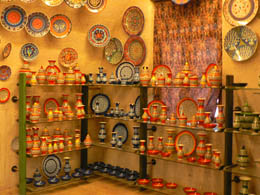
The over-priced goods |
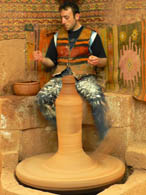
Potter on a kick wheel |
Our next stop was Devrent (Imagination) Valley. Daira identified some of the shapes (Virgin Mary, dancers, camel, turtle, ducks kissing), then she gave us time to explore and imagine on our own. There was a local woman selling her wares in the souvenir shop. The women on our tour asked her questions (using Daira as their translator). She said she was 45 (she looked 75), was married at 13, her son-in-law is cheating on her daughter, and, jokingly, that she would die for her husband. Tough life for women.
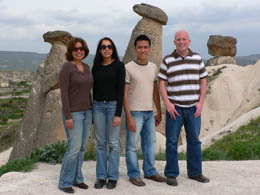
Our sweet tour group |
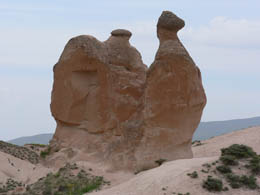
Camel in Imagination Valley |
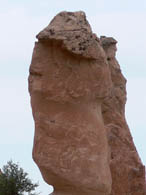
You guessed it in Imagination Valley |
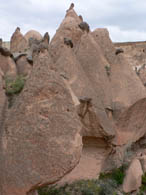
Makeshift bathroom in Imagination Valley |
Our last adventure of the tour was a 1-½-hour hike through the Red and Rose Valleys. The steep trail going down into the valley was a bit treacherous. Again, I had respect for those incredible guys from Seattle. We hiked past vineyards, orchards, forests, caves, and over boulders. We gazed up at the churches, pigeon houses and doorways carved into the porous rock on the steep cliffs. Bill and I loved the hike. It was too much for our younger companions. They were dying when the trail ended at the little town of Cavusin.
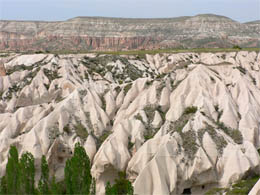
Red and Rose Valleys |
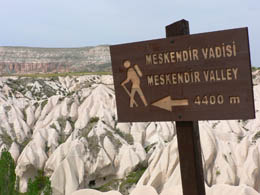
Start the hike |
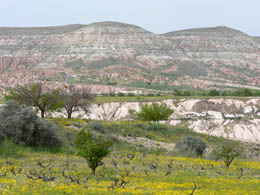
Wildflower carpet in the valley |
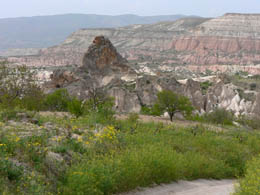
The trail down |
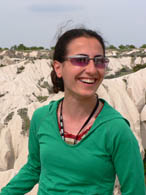
Our fearless leader |
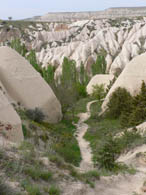
Steep trail down |
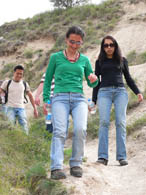
Show us the way to go down |
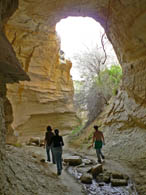
Hike through caves |
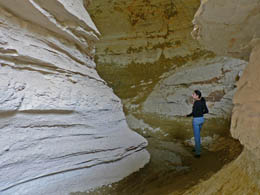
Nature’s sculpture |
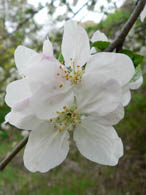
Apple blossoms
|
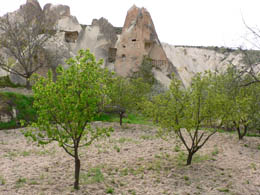
Hike through farmlands
|
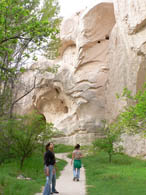
Looking up at canyon |
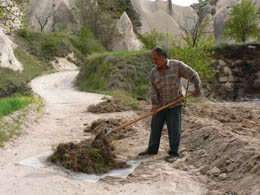
Turkish farmer hard at work |
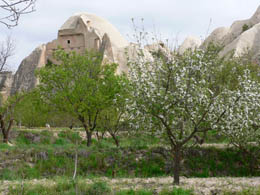
Apple orchard (for that famous apple tea) |
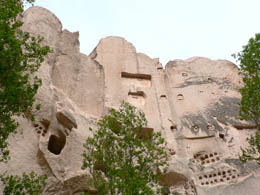
Civilization overhead |
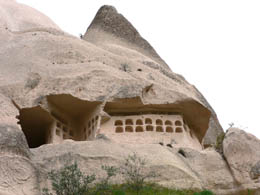
Ancient dwellings (with pigeon houses) |
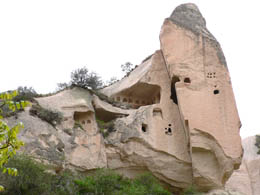
Ancient dwellings |

Ancient dwellings |

Ancient dwellings |

Nancy and Bill look down from an ancient church |

Marvels everywhere |

Bills waits for a beer |

Local farmer tries to get lucky with a cutie pie in our group |
The van delivered us to Goreme. We said goodbye to our companions, bought water and our bus tickets and stopped by the ATM. I went back to our room to relax a little before our big night with the Whirling Dervishes.
We went to dinner at the Local restaurant, which was recommended by our hotel. I thought that with a name like “Local” it would be a plain-cooking kind of place. Wrong! It was fancy and with a resident surly waiter. The salad was good, the mushroom soup uninteresting, and the pistachio-chicken cold and boring. We chocked it down. No time for our free coffee and brandy at Alaturka -- we had to get back to Goreme House for our ride to the Whirling Dervishes.
Mukbale took us in her beat-up, old car to Serihan, halfway between Aksaray and Nevsehir. Serihan is a restored caravansary, originally built in 1192. A caravansary was basically a little fort on the Silk Road where traders could rest safely with their camels and shipping containers at the end of a day. The Seljuks in Turkey were the only ones to provide safe havens for merchants along the trade routes. The buildings were placed approximately 15 to 20 miles apart, the time it takes to travel a day to the next caravansary down the road.
The gates at each caravansary were closed at sunset and opened at sunrise. The large open courtyards in the middle were for the animals and around the courtyards there were sleeping rooms, mosques, coffeehouses, shops, libraries, and clinics. Apparently for hundreds of years, musicians sat just inside the doorway welcoming the visiting traders. Eventually, some clever entrepreneur figured out the concept of insurance. The traders bought “trip insurance” at the caravansary to cover their goods and themselves just in case they didn’t make it to the next stop.
The caravansary in Serihan was impressive and beautifully restored, considering it was designed to be a stopover and warehouse. I could imagine what it was like to be a trader on the Silk Road arriving at such a place at the end of a day. We bought our tickets (25 euros each) to the Dervish show, and then were seated in a back row, high above the massive groups from the tour buses.
The Whirling Dervishes were from the Mevlevi sect from Konya. This sect of Dervishes was started by Mevlana Celaleddi-I Rumi in the 13 th century. The Dervishes on tonight’s program were the real deal and have been chanting and whirling since boyhood. Whirling, as the theory goes, is symbolic of the revolution of everything in the universe.
Our performance began when five or six musicians entered the open area, bowed and took their places on stage next to their strange looking instruments. Next came five whirlers who removed their black robes revealing a white jacket over a full white skirt. They stood dignified for the longest time, transfixed while a haunting voice chanted, followed by a simple flute piece. Finally, the whirlers, with arms folded across their chests, gradually extended their arms – right palm up toward heaven and left palm down toward earth. They cocked their heads with their tall white conical hats (representing Rumi’s tombstone) and then began to spin. Spinning, for them, is a spiritual journey. They spin faster and faster until they can reach out and touch the “ultimate.”
One supervisor-type Dervish, who left his black robe on, walked among the dancing whirlers, checking things out. I thought the performance was very strange and somewhat boring – just 5 guys in funny hats and full skirts whirling with wacky music in the background. The most exciting part of the evening was when Bill was taking videos of the whole thing. An angry usher spotted him and charged up the stairs to admonish him to stop. (We had been warned beforehand that flash photography was prohibited, but didn’t think that applied to video using ambient light.) With no video to occupy his time, Bill became bored and began to snooze.
After the program we spotted Mukbale in the lobby. She was so excited to talk about the program and tell us about the Dervish Sect. She told us that only men are allowed to whirl. When we returned to the hotel courtyard, I tried to get her to do a little whirling with me. She smiled, cocked her head, gracefully lifted her arms, but could not make herself turn. Then we both giggled. I could tell that she is a very good person. |











